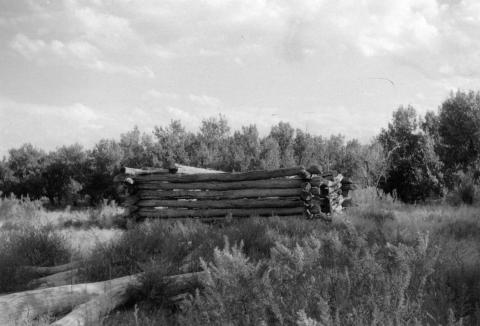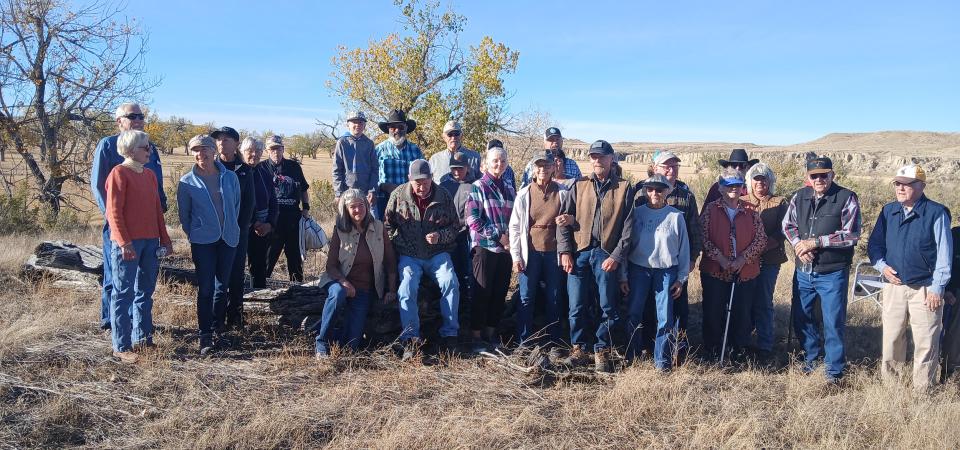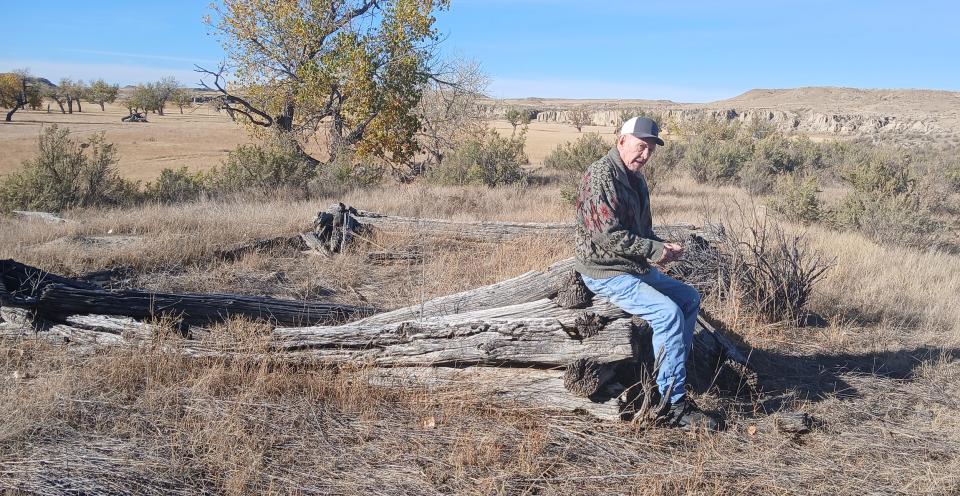An Afternoon on Lightning Creek
By Lucas Keeler
On a gorgeous fall afternoon, 32 history lovers from the Niobrara County and Weston County historical societies met at the site of one of Wyoming’s most infamous and controversial events, the so-called Battle of Lightning Creek. Called the “last blood-spilling fight” between Whites and Native Americans in Wyoming, a series of decisions and acts led up to a fateful day that still sparks debate and outrage.
Native American hunting privileges were a point of contention in 1903, as treaty provisions and Wyoming’s state game laws often conflicted and resulted in fines or jail time for “offenders.” The 1896 United States Supreme Court case of Ward v. Race Horse ruled that Native American treaty hunting rights were inferior to Wyoming state game laws. Despite this ruling that allowed Wyoming to enforce its game laws against Native Americans, the eastern counties of the state still attracted Sioux hunters from South Dakota reservations.
Reports surfaced in October of 1903 of Oglala Sioux leaving the Pine Ridge reservation in South Dakota, and illegally hunting antelope out of season in southern Weston and northern Converse counties. To compound matters, the Oglala were also accused of killing cattle. Sheriff William “Billy” Miller of Weston County obtained a “John Doe and Richard Roe” warrant on Oct. 22 authorizing him to arrest two parties for violating the state game laws. With the warrant in hand, Miller and a small posse set out the following day to make the arrests.
Although the warrant never specifically mentioned the Oglala as the offenders of the poaching accusations, Oglala leader Eagle Feather (also known as Charlie Smith from his Carlisle Indian School days), appeared to be at the forefront of Miller and his men’s search. Smith, along with 18 additional adults and their children, received authorization from United States Indian Agent John R. Brennan to leave the Pine Ridge Reservation with a pass for a medicine-gathering trip in the Black Hills.
Also issued a pass by Brennan was an Oglala party led by William Brown which was comprised of 22 adults and their children. After traversing through Weston County, both Oglala parties converged on a dry fork of the Cheyenne River in Converse County. However, Sheriff Miller and his growing posse were in hot pursuit, following the Pine Ridge residents from Weston into Converse County.
With his warrant issued in Weston County, Miller left his jurisdiction and pursued the Oglala into Converse County. Finding the Eagle Feather and William Brown parties camped together, the warrant was read by Miller. Eagle Feather, fluent in English and savvy in the law, refused to comply. The Oglala broke camp, and still refusing to go to Newcastle, prepared to return to Pine Ridge.
Miller and the posse persisted. Camping at the Fiddleback Ranch on the night of Oct. 30th, they resumed their pursuit the following morning, heading south and farther into Converse County. Additional men were brought into the posse including a wolf hunter from Douglas named Louis Falkenburg, and former Newcastle lawman and so-called Indian fighter John Owens. Scouts were sent ahead by Miller to find the direction in which the Oglala had gone, and instructions were given that the posse would rendezvous later in the day at the Lightning Creek cow camp of rancher Jake Mills.
On the afternoon of the 31st, the Miller party reached its destination on Lightning Creek. Coincidently, the Eagle Feather and Brown parties were traveling north along a wagon trail, parallel to Lightning Creek, when they came into view. The Oglala appeared to be startled. Miller instructed them to surrender.
Shots were fired, and panic ensued. Who fired first is still debated to this day. The first to be killed was an 11-year-old Oglala boy named Peter White Elk. Deputized sheriff Louis Falkenberg was shot in the neck. He too died instantly. Black Kettle and Gray Bear were also killed. Eagle Feather, his wife Susie, and Sheriff Miller were gravely wounded. The fighting lasted a mere five minutes. Four were dead, and three lay dying.
The cabin of Jake Mills lay nearby. It was there that Billy Miller, his blood gushing uncontrollably from the shot to the femoral artery, was taken. Within 30 minutes the popular sheriff from Newcastle was dead. Some say he died a martyr, others say he died a fool.
The Oglala said that Sheriff Miller’s posse (with Johnny Owens as the prime suspect) fired first. The posse countered that a shot from Black Kettle’s rifle came first. After later interviewing the Oglalas, U.S. Attorney John Burke said the posse had taken up a position that was “threatening and menacing,” implying that they had fired from ambush.
The land where the battle took place became a part of Niobrara County in 1911. Rancher Dave Thomson’s family has owned the land since his father, Roderick “Zip” Thomson, homesteaded it in 1916. Thomson spoke candidly this month about the events of the battle to the group and indicated his “softness” towards the Oglala.

The events that day were fresh upon “Zip” Thomson’s arrival, and the father shared what he knew with his son, and his son in turn has shared it with others. Thomson has frequently spoken to groups in the past about the battle, and many have been privileged to see that site. However, this trek was comprised of the largest group yet, believed Thomson.
The Jake Mills cabin overlooks cottonwoods along Lightning Creek, westerly towards the scene of the unnecessary carnage. Although in a deteriorating state, remnants of the cabin remain. An eroding sandstone marker is placed near a corner, its simple words read “Cabin Where Sheriff Billie Miller Died Oct. 31, 1903.” The presence of both the dying Sheriff Miller and the Oglala leader Eagle Feather can still be felt.
From the cabin’s vantage point, it’s easy to imagine the strung-out wagon caravan of Oglala men, women, and children approaching Lightning Creek. Sheriff Miller’s posse lying in wait, trigger happy to relive the “Indian fighting” days of old. The landscape is surreal, the power of its mystique draws one in.
Special thanks to the organizers of the trek, Jim Kruse and JoAnn Wade, for their leadership in putting the event together. More importantly, a thank you to Dave Thomson and his daughter, Kristol Miller, for granting access to their ranch, sharing stories about their family, and showing us the “Battle of Lightning Creek.”
[Historian Lucas Keeler of Newcastle is active in the Wyoming and Weston County Historical Societies.]
Read TROUBLE AT LIGHTNING CREEK: “A STAINED PAGE IN WYOMING’S HISTORY”


